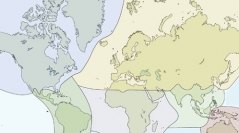

 European Journal of Taxonomy
2019 (492) - Pages 1-135
European Journal of Taxonomy
2019 (492) - Pages 1-135We present an updated, subjective list of the extant, non-marine ostracod genera and species of the world, with their distributions in the major zoogeographical regions, as well as a list of the genera in their present hierarchical taxonomic positions. The list includes all taxa described and taxonomic alterations made up to 1 July 2018. Taxonomic changes include 17 new combinations, 5 new names, 1 emended specific name and 11 new synonymies (1 tribe, 4 genera, 6 species). Taking into account the recognized synonymies, there are presently 2330 subjective species of non-marine ostracods in 270 genera. The most diverse family in non-marine habitats is the Cyprididae, comprising 43.2% of all species, followed by the Candonidae (29.0%), Entocytheridae (9.1%) and the Limnocytheridae (7.0%). An additional 13 families comprise the remaining 11.8% of described species. The Palaearctic zoogeographical region has the greatest number of described species (799), followed by the Afrotropical region with 453 species and the Nearctic region with 439 species. The Australasian and Neotropical regions each have 328 and 333 recorded species, respectively, while the Oriental region has 271. The vast majority of non-marine ostracods (89.8%) are endemic to one zoogeographical region, while only six species are found in six or more regions. We also present an additional list with ‘uncertain species’, which have neither been redescribed nor re-assessed since 1912, and which are excluded from the main list; a list of taxonomic changes presented in the present paper; a table with the number of species and % per family; and a table with numbers of new species described in the 20-year period between 1998 and 2017 per zoogeographical region. Two figures visualize the total number of species and endemic species per zoogeographical region, and the numbers of new species descriptions per decade for all families and the three largest families since 1770, respectively.
Ostracoda, distribution, biodiversity, taxonomy, nomenclature.